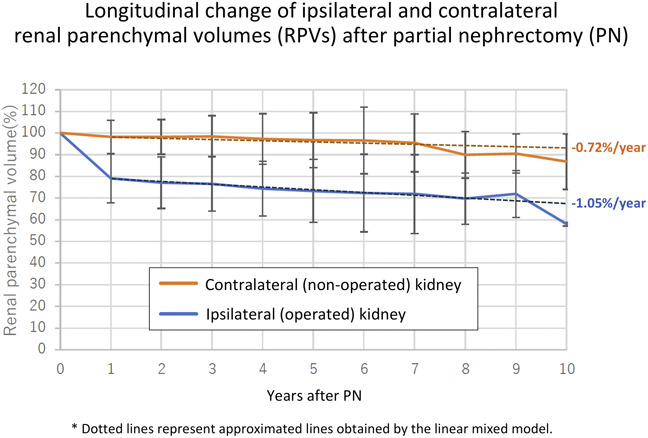Introduction and objectives
Functional outcomes after partial nephrectomy (PN) depend on the ipsilateral (ipsi-) renal parenchymal volume (RPV) preserved. New-baseline RPV early after PN has been widely studied; however, a longitudinal change of RPV beyond the new baseline has not been well examined. In this study, we investigated the annual change of eGFR after PN as well as ipsi-RPV in comparison to the contralateral (contra-) RPV in patients with preexisting chronic kidney disease (CKD).
Methods
76 patients with preoperative eGFR <60 mL/min/1.73m2 who received PN for an unilateral primary renal tumor were analyzed. Patients with solitary kidney, metastatic disease, or renal recurrences developed after PN were excluded. Ipsi- and contra-RPVs before/after PN were measured on CT images. %RPV was defined as RPV after PN normalized by that before PN. The new baseline was defined as 6-12 months after PN and the annual changes of eGFR and %RPVs after the new baseline were assessed using linear mixed model.
Results
Median age was 66 and 60 patients (76%) were male. 48 (63%), 11 (15%), and 8 (11%) had hypertension, diabetes, and cardiovascular diseases, respectively. Median tumor size was 2.6 cm and R.E.N.A.L. was 7. Acute kidney injury (AKI) occurred in 13 patients (17%) after PN. Median follow-up was 4.6 years. Median eGFR was 53.2 before PN; it decreased to 50.7 at the new baseline and gradually declined at -0.99/year (95%CI: -1.21, -0.77) afterward. Median ipsi- and contra-RPVs before PN were 124 cm3 and 129 cm3, respectively. After PN, median %ipsi-RPV was 81% at the new baseline and declined at -1.05%/year (95%-CI: -1.31, -0.79) afterward, while %contra-RPV declined at -0.72%/year (-1.05, -0.37). The decrease of %ipsi-RPV from the new baseline to the last follow-up was larger than %contra-RPV (median, -4.2% vs. -1.2%; p=0.001). In multivariable analysis, cardiovascular diseases, larger tumor size, and AKI after PN were associated with a significant decrease of %ipsi-RPV from the new baseline.
Conclusions
In patients with preexisting CKD, eGFR and RPVs gradually declined from the new baseline after PN. The longitudinal decrease of RPV was more pronounced in the operated kidney, which could be affected by cardiovascular morbidities and the extent of surgical manipulation during PN.

Source of Funding
None